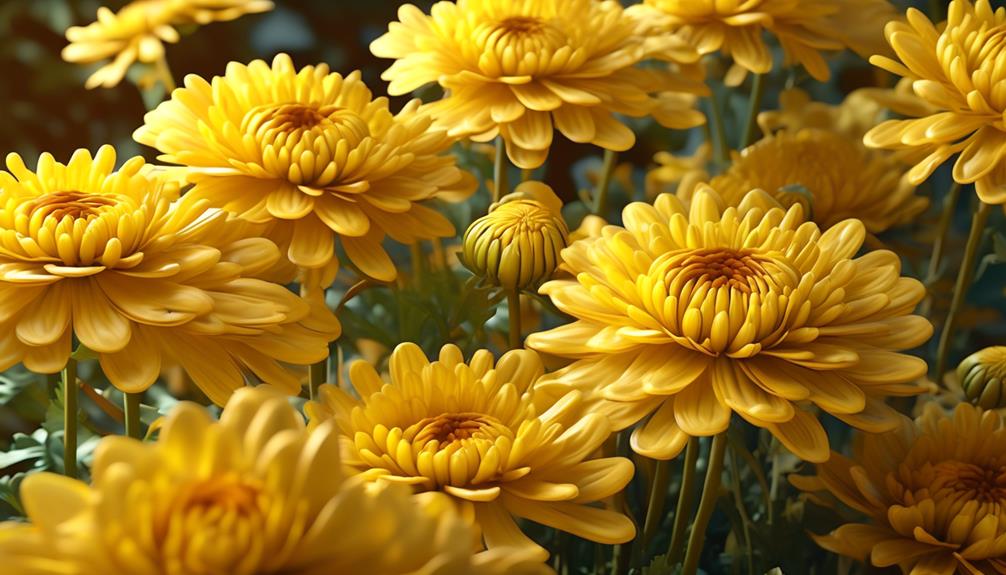As you step into the autumn garden, your eyes are immediately drawn to a burst of sunshine amidst the fading hues of the season. The Yellow Chrysanthemum, like a radiant sun, stands tall and proud, captivating all who lay eyes upon it.
But there is more to this remarkable flower than meets the eye. In this discussion, we will uncover the fascinating story and origins of the Yellow Chrysanthemum, explore its cultural significance, and unravel the mysteries behind its colorful petals.
Get ready to be enthralled by the beauty and allure of this captivating flower, as we embark on a journey through the sunlit realms of the autumn garden.
Blooming Patterns and Colors
When it comes to blooming patterns and colors, chrysanthemums offer a vibrant array of options that are sure to captivate any garden enthusiast. With their bright yellow petals, chrysanthemums are a striking addition to the autumn garden. Not only do they add a pop of color, but they also symbolize happiness and joy.
These beautiful flowers attract bees and butterflies, creating a lively and buzzing atmosphere in your garden. Chrysanthemums come in various shapes and sizes, including discs, daisies, anemones, pompoms, and spiders. Their color palette is extensive, encompassing every shade except blue.
With their long-lasting blooms, chrysanthemums are perfect for cut flower arrangements, brightening up any room. So, if you're looking to add a touch of sunshine to your autumn garden, look no further than the vibrant chrysanthemum.
Story and Origins
Chrysanthemums, with their vibrant colors and rich history, have a fascinating story and origins. Native to East Asia, these flowers have been cultivated for centuries and are renowned for their use in traditional medicine. In fact, they're even considered the birth flower for November.
Chrysanthemums come in a variety of colors, but the Anastasia Sun Chrysanthemums with their bright yellow petals are particularly popular for floral arrangements. To start your own chrysanthemum garden, you can buy young plants in spring or potted plants in the fall. Make sure to provide at least five hours of sunlight a day and use organically rich, slightly acidic soil.
With proper care, these beautiful flowers will thrive in your garden.
Cultural Significance
As you explore the cultural significance of chrysanthemums, you'll discover the deep-rooted symbolism and joyful associations these bright yellow flowers hold. Chrysanthemums, especially the Anastasia Sun variety, are associated with happiness and joy, making them popular choices for floral arrangements and decorations. These flowers symbolize happiness and attract bees and butterflies, adding to their cultural importance. Chrysanthemums have a long history of cultivation and are native to East Asia, where they are not only used for their aesthetic appeal but also hold significance in traditional medicine. In fact, they are even designated as the birth flower for November. The autumn garden provides the perfect environment for chrysanthemums to thrive, making them not just a beautiful addition to the garden but also culturally symbolic. Different types of chrysanthemum flowers are used in various cultural practices, reflecting their cultural importance. Take a look at the table below to see the different cultural associations of chrysanthemums:
| Cultural Association | Meaning |
|---|---|
| Happiness | Joy |
| Prosperity | Success |
| Longevity | Health |
The cultural significance of chrysanthemums goes beyond their visual appeal, making them a cherished symbol in various cultures.
Colorful Petals
With their vibrant yellow petals, Anastasia Sun Chrysanthemums add a burst of color to the autumn garden, symbolizing happiness and joy. These eye-catching flowers belong to the vibrant Chrysanthemum family and are known for attracting bees and butterflies, making them versatile for floral design.
Chrysanthemums come in various shapes and sizes, and they're native to East Asia. Historically, they've been used in traditional medicine and are the birth flower for November. As the last bright splash of color in the autumn and winter garden, Chrysanthemums thrive in the right temperature and sunlight.
To start a Chrysanthemum garden, you can buy young plants in spring, start plants from cuttings, or purchase potted plants in fall, each providing their own unique display of color.
Watering Frequency
To ensure healthy growth, water chrysanthemums deeply, allowing the soil to dry slightly between waterings to prevent root rot. Adjust the watering frequency based on weather conditions to ensure proper moisture levels for optimal growth.
It's important to water in the morning to allow the foliage to dry before evening, reducing the risk of diseases. When watering, use a watering can or soaker hose to water at the base of the plant, avoiding wetting the foliage.
Regularly monitor the soil moisture and adjust the watering frequency as needed to maintain the ideal growing conditions.
Gift-Giving Occasions
After ensuring the proper watering frequency for your chrysanthemums, it's time to explore the perfect occasions for gifting these vibrant plants.
Chrysanthemum plants make wonderful gifts for fall birthdays, anniversaries, or as a gesture of appreciation for loved ones. They're ideal for housewarming gifts, adding a touch of autumn charm to the recipient's home and garden.
Chrysanthemum floral arrangements are perfect for expressing sympathy and condolences during the fall season. Giving potted chrysanthemums is a thoughtful way to bring joy to someone's day, making them a great choice for get-well-soon gifts.
And don't forget, chrysanthemum bouquets are a beautiful and meaningful gift for celebrating Thanksgiving, bringing a touch of seasonal beauty to the occasion. So, whether it's for a special occasion or just to brighten someone's day, chrysanthemums are the perfect gift choice.
Concluding Thought
Summing up the key takeaways and providing a final perspective on chrysanthemums and their care, let's explore the significance and versatility of these vibrant plants. Throughout this article, we have delved into the various aspects of chrysanthemums, from their historical importance to their use in garden landscaping and floral arrangements. By following the essential tips and insights provided, you can successfully cultivate these beautiful flowers and enjoy their unique characteristics. To further enhance your understanding, take a look at the table below, which highlights some key points about chrysanthemums:
| Aspects | Significance and Versatility |
|---|---|
| Historical Value | Symbol of longevity and joy |
| Colors | Range from bright and bold to soft and pastel |
| Care Tips | Regular watering and proper sunlight |
| Uses | Garden decoration, indoor display, and floral arrangements |
| Characteristics | Diverse shapes, sizes, and petal patterns |
Frequently Asked Questions
Are Yellow Chrysanthemums Annuals or Perennials?
Yellow chrysanthemums, like the Anastasia Sun Chrysanthemums, are perennials, meaning they come back year after year. They thrive in autumn gardens, adding a burst of bright yellow color.
Is Yellow Chrysanthemum Indoor or Outdoor?
Yellow chrysanthemums are outdoor plants, thriving in the autumn garden. They require at least 6 hours of full sun, making them ideal for landscaping. Add a pop of color to your outdoor space with these vibrant flowers.
Do Chrysanthemums Come Back Every Year?
Yes, chrysanthemums come back every year, adding a burst of vibrant colors to your garden. With proper care, these low-maintenance perennials will keep blooming, attracting bees and butterflies, and bringing beauty to your autumn garden.
What Is the Symbolism of the Chrysanthemum?
The symbolism of the chrysanthemum is happiness and joy. Its bright yellow color attracts bees and butterflies, adding a pop of color to any floral arrangement. It is a popular choice for weddings and special occasions.





